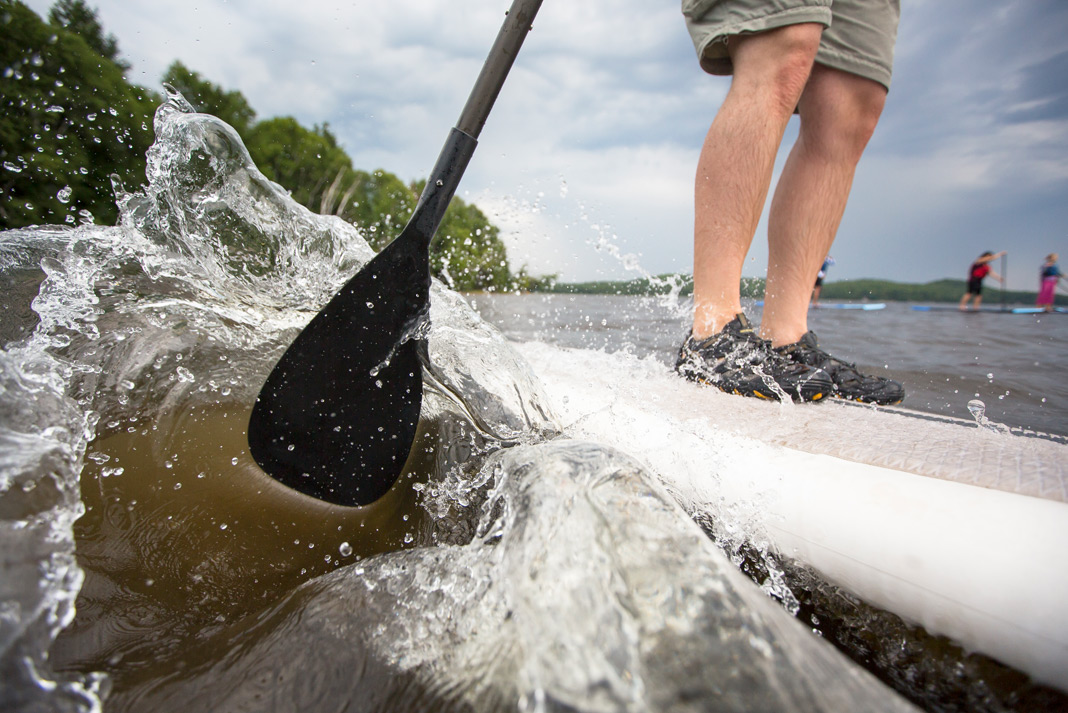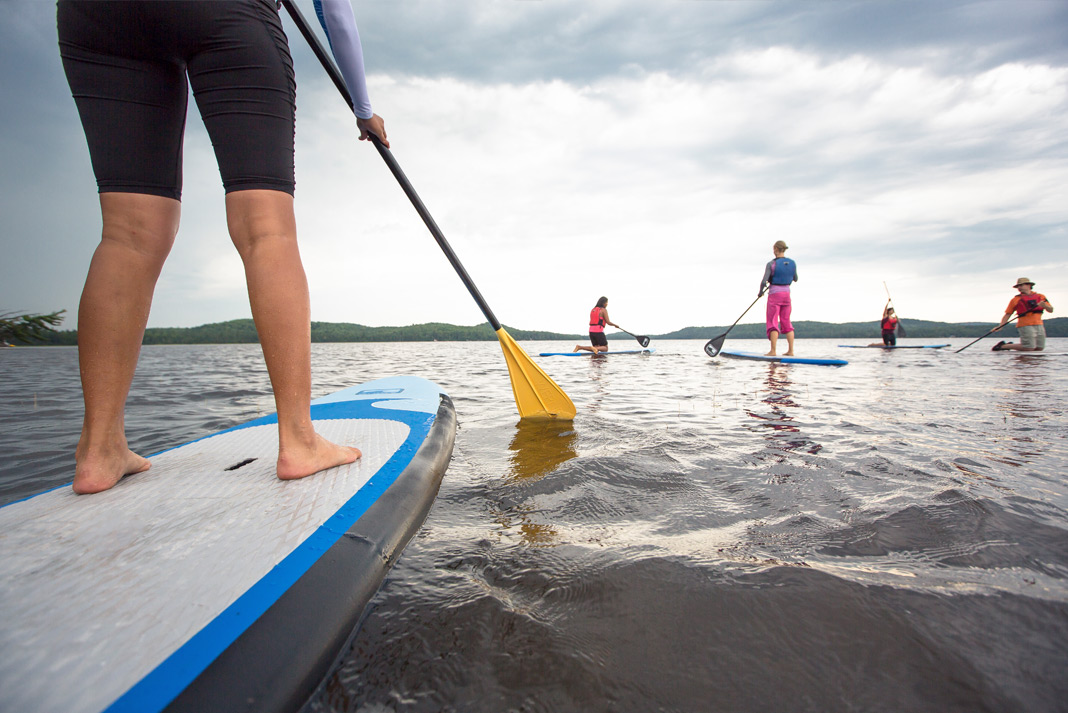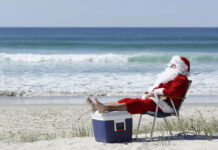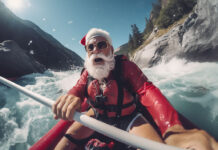Many standup paddleboarders have a vivid memory of their first time encountering the sport of SUP. Maybe they witnessed someone gliding across the water at the beach, or perhaps they saw a crazy SUP surfing video on the internet.
Wherever people first see someone floating on top of the water, the reaction is often the same: I want to try that.
Standup paddleboarding has grown massively over the past decade or so. It has gone from a sport that stops and makes people take notice, to something that can be tried by renting a board on just about any major beach in the world. Whether true or just a myth, SUP is often said to be the fastest-growing watersport on earth. And judging by how many people now own the boards, it’s hard to argue that fact.

Where the sport was first invented is up for debate, but its roots go back to surfers in Hawaii who wanted a fun option for being on the water when the ocean was flat. It was also used by surf instructors during lessons.
Standup paddleboarding really started to pick up steam in the United States in the late 1990s and early 2000s, before becoming massively popular in the mid- to late-2010s.
Interestingly, the term “paddleboarding,” can actually mean different things to different people. That term alone often refers to prone paddleboarding, where someone lies or kneels face down on a board and paddles with their arms in a swimming motion. Standup paddleboarding, or SUP, are obviously a variation of that. But because of the sport’s popularity, many people have dropped the “standup” and just refer to the act of standing on a board and paddling as standup paddleboarding.
General questions about standup paddleboarding
How hard is it to do standup paddleboarding?
As someone who introduces many new people to the sport, this is a common question. Oftentimes, people will see someone else paddleboarding and think that it’s an extremely difficult balancing act, like walking on a slackline or riding a unicycle.
However, the answer to the question of how to paddleboard is quite simple: stand up, relax and have fun. Unlike slacklining or riding a unicycle, the worst consequence of losing your balance on a SUP is falling in the water.
The best way to get started is to go standup paddleboarding with an instructor, or an experienced friend. Some of the bad habits that can make the activity seem more difficult than it needs to be are easily corrected by people who know what they’re doing.
If that’s not an option, and you want to simply borrow or rent a board and give it a try on your own, patience is key. You may fall in at first, but with proper technique and a bit of practice, you’ll be exploring your local body of water in no time.
Can you paddleboard if you can’t swim?
Unlike some other types of vessels on the water, a standup paddleboard is just about impossible to sink. There are some exceptions, of course, but most SUPs are constructed of a foam core, which is what gives it the buoyancy to keep you floating as you paddle around.
But when it comes to personal safety, the unsinkable nature of paddleboards can be both a blessing and a curse. Many people think that because they’re paddling on a vessel that won’t sink, they don’t need to wear a personal flotation device (PFD). The problem is that accidents do still happen, and you should always be wearing a PFD—regardless of what the local marine regulations or the sometimes lenient rules at rental places might say.
The other hugely important piece of safety equipment you should almost never go without is a leash. These attach to the rear of the board and then wrap around your ankle or calf. If you fall off your paddleboard, this is your lifeline. This is what keeps you attached to the board, and allows you to pull the SUP back toward you if you fall in the water. They’re crucial pieces of safety gear worn by even the most experienced standup paddleboarders.
How to prepare for paddleboarding
So if you’re ready to take the plunge (metaphorically speaking), the first step is knowing what you need to have with you on the board. Chances are, your first experience on a standup paddleboard is going to end up with you in the water at some point, so leave your phone, car keys, camera and anything else you don’t want to end up at the bottom of the lake on dry land, or in a drybag that’s secured to the board. Wearing a bathing suit is also a good idea.
This isn’t like paddling a canoe where there’s a high likelihood only your shoes will get wet. If you’re thinking about paddling in colder seasons, make sure you’re dressed to fall in. Even the most experienced paddlers, who rarely fall in, will wear full drysuits with sealed boots in the winter so that if they do end up in the water, they won’t experience the dangerous shock of cold water.
Of course, don’t forget the basics. You’ll also need your paddle, leash, PFD and whatever other safety items are required by your local laws. In some places, for example, having a whistle attached to your PFD is mandatory.
Another important step is to let someone know when you’re heading out on the water. Paddling in pairs is always recommended, but if you’re trekking solo, make sure somebody knows when and where you’re leaving from, the general route you’re taking (especially if you’re headed onto a waterway with a number of directional options) and when you expect to be back on shore.
How to paddleboard
How to get up on a standup paddleboard
For people who have never been on a SUP before, this can be the hardest and most intimidating part.
A quick note: The handle in the center of the board is an important reference point we’ll use as it’s the centre of balance for carrying or standing on your SUP.
We’ll start with the easiest launch point, which is a beach with a sandy bottom. Walk the board out into the water deep enough to the point where the fin isn’t touching the bottom when you push down on the back of the board. Hold your paddle across the board in front of the center handle. Next, climb onto the board on your knees. From here, you can start out by paddling while on your knees to get a feel for how the paddleboard moves under you, or just take the next step (literally) and push yourself up into a standing position.
From a dock, you have to be a little bit more careful because falling could lead to hitting the dock structure. Depending on the height of the dock, you can sit on the edge with your feet on the board, set your paddle onto it and then either kneel or stand up, using the dock for stability as you push off.
Some people find getting back onto the board after falling off in deeper water is also a challenge. You won’t have the benefit of pushing off the lake or river bottom, so you’ll need to pull yourself onto the board stomach first, and then from a prone position, work yourself up to your knees, and then your feet.
If you need a rest, yes, you can sit on a paddleboard. Climb onto the board, sit yourself down and give yourself a minute to catch your breath.
How to stand on a paddleboard
Knowing where to stand on a paddleboard is key to being balanced and comfortable. As mentioned, the handle is the center point of the board, so start out with your feet shoulder-width apart in line with the handle. Try to relax your legs. The more you can use your knees to absorb the movement of the water through the board, the more stable you’ll be. Shift your weight left and right to unbalance the board and learn how stable the board is.
How to hold a paddleboard paddle
Unlike a kayak paddle, where your hands should be equally spaced on the shaft, a paddleboard paddle should be held with one hand on top of the handle at the end of the paddle, and the other part way down the shaft. Figuring out the exact length of paddle and hand position is a science unto itself, but a good place to start is that the paddle should be at least a few inches longer than you are tall.
How to paddle SUP boards
Learning proper SUP paddling technique takes some time, but the basic maneuver is to pivot at the hips, reach forward to plant the whole blade in the water, and then move the blade toward your feet as you stand up straight. Rather than thinking about moving the water with your paddle, think of it as planting your blade in the water and then pulling your board forward.
To stay in a straight line, keep your paddle as vertical as possible as you go through the stroke. The longer the board, the straighter it will go, but no matter what length you’re on, you’ll need to switch between paddling on the left and right side of the board.
Wondering how to turn on a standup paddleboard? Experienced paddlers will use a pivot turn, where you walk to the back of the board, pop the nose out of the water and then paddle on the opposite side to the direction you want to turn. As the name of the technique suggests, you can make very tight turns this way. The other option is to drag your paddle or back paddle on the side of the turn you want to make.

Where to paddleboard
As you begin to standup paddleboard, you’ll start to become aware of every lake, river and pond around you because you’ll want to explore them.
Standup paddleboarders just starting out should stick to water they’re familiar with that doesn’t have a strong current, undertow or big waves. The flatter the water the better as you learn the balance and technique of being on a SUP.
As you get more comfortable on the board, expand your horizons and enjoy the adventure that comes with gliding across the water.
How to paddleboard in the ocean
Ocean paddling can be an exhilarating and incredible experience, but it can also be extremely dangerous. If paddling in the ocean is your only option, or you’re on vacation and want to try paddleboarding for the first time, only hit the water on a calm day. Trying to learn to SUP in waves can be a frustrating experience, and may make you want to give up and not try it again.
Before you give ocean paddling (or any big body of water with significant waves) a try, make sure you’re comfortable balancing on the board and feel like you can turn it without much difficulty.
How to paddleboard on a river
River paddling is also a fun adventure, and a standup paddleboard offers a great vantage point to take in the nature around you. But caution should be taken with unfamiliar waterways. Make sure you know the area before setting out, and check with your local conservation authority to make sure the water depths or flow rates will allow for safe paddling. If you’re paddling in shallow water, consider using an inflatable paddleboard and flexible fins to avoid causing damage.
How to improve balance for paddleboarding
At first glance, standup paddleboarding appears to be entirely an arm workout, but newcomers to the sport often find it’s their legs and core that are more sore than anything. The better your balance gets, the more the workout will shift to being about the arms or whole body. To improve your balance for paddleboarding, things like balance boards or bosu balls are extremely beneficial. Weight training aimed at strengthening your legs will help you stabilize on the board.
Beyond that, strengthening your core, back, shoulders and arms will help make you a better, more well-rounded standup paddler.









Excellent article! Thank you for highlighting important safety information. As an instructor to beginner SUP board paddlers and a lifeguard, I greatly appreciate your advice on wearing a PFD and leash. It is important to share your paddle plan and be wearing weather-appropriate/sport-appropriate clothing too. Definitely sharing this article with my peeps.